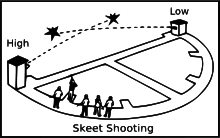  |



  "Skeet shooting was invented by William Harden Foster, an avid grouse hunter, in the
1920's as a sport called "Clock Shooting." The original course was a circle with a radius
of 25 yards with its circumference marked off like the face of a clock and a trap set at
the 12 o'clock position. The practice of shooting from all directions had to cease,
however, when a chicken farm started next door. The game evolved to its current setup
by 1923 when Foster solved the problem by placing a second trap at the 6 o'clock
position and cutting the course in half. Foster quickly noticed the appeal of this kind of
competition shooting, and set out to make it a national sport. The game was introduced
in the February 1926 issue of National Sportsman and Hunting and Fishing magazines,
and a prize of 100 dollars was offered to anyone who could come up with a name for
the new sport. The winning entry was "skeet" chosen by Gertrude Hurlbutt. The word
"skeet" was said to be derived from the Scandinavian word for "shoot" (skyte). During
World War II, skeet was used by the American military to teach gunners the principle of
leading and timing on a flying target."
"Skeet shooting was invented by William Harden Foster, an avid grouse hunter, in the
1920's as a sport called "Clock Shooting." The original course was a circle with a radius
of 25 yards with its circumference marked off like the face of a clock and a trap set at
the 12 o'clock position. The practice of shooting from all directions had to cease,
however, when a chicken farm started next door. The game evolved to its current setup
by 1923 when Foster solved the problem by placing a second trap at the 6 o'clock
position and cutting the course in half. Foster quickly noticed the appeal of this kind of
competition shooting, and set out to make it a national sport. The game was introduced
in the February 1926 issue of National Sportsman and Hunting and Fishing magazines,
and a prize of 100 dollars was offered to anyone who could come up with a name for
the new sport. The winning entry was "skeet" chosen by Gertrude Hurlbutt. The word
"skeet" was said to be derived from the Scandinavian word for "shoot" (skyte). During
World War II, skeet was used by the American military to teach gunners the principle of
leading and timing on a flying target."A round of skeet consists of 25 targets in a set sequence of singles and simultaneous doubles. Squads of five shooters take their turns from eight shooting stations. Each squad member takes two singles and one double from stations 1, 2, 6, and 7. Two singles are taken from stations 3, 4, 5, and 8. The 25th target is taken after the first target is missed or as a final target (low house #8) after 24 kills. Targets are thrown a distance of 60 yards. Variations in the angles of the targets presented from the "high" and "low" house result from the shooter moving from station to station. You may download a detailed diagram of the skeet field with the suggested leads for each shot, here. American Skeet is the only discipline that has regular, specific tournament events for sub-bore shotguns: 20, 28, and .410.  Skeet Doubles
Skeet DoublesShooters, in squads of five, start on station 1, shooting one pair of doubles each to station 7. Then they reverse, shooting one pair each from stations 7 through 1. On station 4, shooters must shoot the high house target first. On reversing, (shooting 7 through 1), they must shoot the low house target first. In tournaments, the events are on a total of 50 (or 100) targets with the last pair shot on station 1. Unlike regular skeet, in Doubles there is no option which is shot when the first target of a round is missed. Scoring is one point per hit target. The video below shows the single targets from each station. Notice the hold points where the gun starts, the look points in the red ovals and how the gun stays ahead of the target throughout the shot sequence. The video is best viewed in half speed or less. |